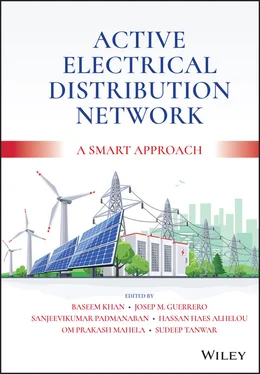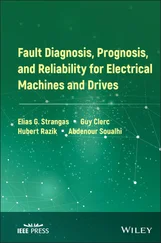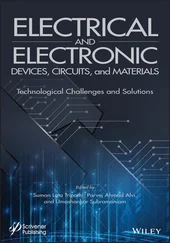Active Electrical Distribution Network
Здесь есть возможность читать онлайн «Active Electrical Distribution Network» — ознакомительный отрывок электронной книги совершенно бесплатно, а после прочтения отрывка купить полную версию. В некоторых случаях можно слушать аудио, скачать через торрент в формате fb2 и присутствует краткое содержание. Жанр: unrecognised, на английском языке. Описание произведения, (предисловие) а так же отзывы посетителей доступны на портале библиотеки ЛибКат.
- Название:Active Electrical Distribution Network
- Автор:
- Жанр:
- Год:неизвестен
- ISBN:нет данных
- Рейтинг книги:5 / 5. Голосов: 1
-
Избранное:Добавить в избранное
- Отзывы:
-
Ваша оценка:
- 100
- 1
- 2
- 3
- 4
- 5
Active Electrical Distribution Network: краткое содержание, описание и аннотация
Предлагаем к чтению аннотацию, описание, краткое содержание или предисловие (зависит от того, что написал сам автор книги «Active Electrical Distribution Network»). Если вы не нашли необходимую информацию о книге — напишите в комментариях, мы постараемся отыскать её.
Discover the major issues, solutions, techniques, and applications of active electrical distribution networks with this edited resource Active Electrical Distribution Network: A Smart Approach
Active Electrical Distribution Network: A Smart Approach
Active Electrical Distribution Network — читать онлайн ознакомительный отрывок
Ниже представлен текст книги, разбитый по страницам. Система сохранения места последней прочитанной страницы, позволяет с удобством читать онлайн бесплатно книгу «Active Electrical Distribution Network», без необходимости каждый раз заново искать на чём Вы остановились. Поставьте закладку, и сможете в любой момент перейти на страницу, на которой закончили чтение.
Интервал:
Закладка:
18 [ 18] J.S. Savier and D. Das, “Impact of network reconfiguration on loss allocation of radial distribution systems,” IEEE Transactions on Power Delivery, vol. 22, no. 4, 2007.
19 [ 19] E. Dolatdar, S. Soleymani and B. Mozafari, “A new distribution network reconfiguration approach using a tree model,” International Journal of Computer, Electrical, Automation, Control and Information Engineering, vol. 3, no. 10, 2009.
20 [ 20] D. Shirmohammadi and H.W. Hong, “Reconfiguration of electric distribution networks for resistive line loss reduction,” IEEE Transactions on Power Systems, vol. 4, no. 1, pp. 1492–1498, 1989.
21 [21] H.D. Chiang and J.J. Rene, “Optimal network reconfiguration in distribution systems: Part 1: A new formulation and a solution methodology,” IEEE Transactions on Power Delivery, vol. 5, no. 4, pp. 1902–1908, 1990.
22 [22] H.D. Chiang and J.J. Rene, “Optimal network reconfiguration in distribution systems: Part 2: Solution algorithms and numerical results,” IEEE Transactions on Power Delivery, vol. 5, no. 3, pp. 1568–1574, 1990.
23 [ 23] S. Civanlar, J.J. Grainger, H. Yin, and S.S.H. Lee, “Distribution feeder reconfiguration for loss reduction,” IEEE Transactions on Power Delivery, vol. 3, no. 3, pp. 1217–1223, 1988.
24 [ 24] D.T. Rizy, W.T. Jewell, and J.P. Stovall, “Operational and design considerations for electric distribution system with dispersed storage and generation (DSG),” IEEE Transactions on Power Aparatus System, vol. 104, pp. 2864–2871, 1985.
25 [ 25] K. Aoki, H. Kawabara, T. Satoh, and M. Kanezashi, “An efficient algorithm for load balancing of transformers and feeders,” IEEE Transactions on Power Delivery, vol. 3, no. 4, pp. 1865–1872, 1998.
26 [ 26] R.E. Lee and C.L. Brooks, “A method and its application to evaluate automated distribution control,” IEEE Transactions on Power Delivery, vol. 3, pp. 1232–1240, 1988.
27 [ 27] C.C. Liu, S.J. Lee, and S.S. Venkata, “An expert system operational aid for restoration and loss reduction of distribution system,” IEEE Transactions on Power Delivery, vol. 3, pp. 619–625, 1988.
28 [ 28] T. Taylor and D. Lubkeman, “Implementation of heuristic strategies for distribution feeder reconfiguration,” IEEE Transactions on Power Delivery, vol. 5, pp. 239–245, 1990.
29 [ 29] C.S. Chen and M.Y. Cho, “Determination of critical switches in distribution systems,” IEEE Transactions on Power Delivery, vol. 7, no. 3, pp. 1443–1448, 1992.
30 [ 30] J. Kennedy and R. Eberhart, “Particle swarm optimization,” Proceedings of IEEE International Conference on Neural Networks, pp. 1942–1948, 1995.
31 [ 31] S.K. Goswami and S.K. Basu, “A new algorithm for the reconfiguration of distribution feeders for loss minimization,” IEEE Transactions on Power Delivery, vol. 7, no. 3, pp. 1484–1491, 1992.
32 [ 32] T. Niknam and E. Azad Farsani, “A hybrid evolutionary algorithm for distribution feeder reconfiguration,” Science China Technology Science, vol. 53, pp. 950–959, 2010.
33 [ 33] N. Suman and S. Rana, “Network reconfiguration for electrical loss minimization,” International Journal of Instrumentation, Control and Automation (IJICA), vol. 1, pp. 2231–1890, 2011.
34 [ 34] S. Kalambe and G. Agnihotri, “Loss minimization techniques used in distribution network: Bibliographical survey,” Renewable and Sustainable Energy Reviews, vol. 29, pp. 184–214, 2014.
35 [ 35] S.P. Kartikeyan, J. Raglend, P. Prathyusha, and D.P. Kothari, “A new methodology for distribution system feeder reconfiguration,” International Journal of Energy, vol. 2, no. 1, pp. 9–15, 2008.
36 [ 36] Energy Statistics, 2019 (Twenty Sixth Issue), Central Statistics Office, Ministry of Statistics and Programme Implementation, Government of India, New Delhi, 2019.
37 [ 37] L. Zhechao, S. Jazebi, and F. de Le´ On, “Determination of the optimal switching frequency for distribution system reconfiguration,” IEEE Transactions on Power Delivery, vol. 32, no. 4, pp. 2060–2069, 2017.
3 Existing Problems Related to Electrical Distribution Network, Part 2 Technical, Economical, and Environmental
Shilpa Kalambe1, Sanjay Jain2, Bhojraj N. Kale3, and, Ujwala B. Malkhandale4
1Electrical Engineering Department, Dr. Babasaheb Ambedkar College of Engineering and Research, Nagpur, M.S., India
2Electronics and Electrical Engineering Department, R.K.D.F. University, Bhopal, M.P., India
3Mechanical Engineering Department, Dr. Babasaheb Ambedkar College of Engineering and Research, Nagpur, M.S., India
4Electrical Engineering Department, Priyadarshini Indira Gandhi College of Engineering, Nagpur, M.S., India
3.1 Introduction
The rigorously growing advancements in the technologies and theories discovered for upgrading and updating the performance of a power system have affected the traditionally trailing operating scenario. This ultimately has unveiled many fields for researchers to study and show their skills in bringing back the normal state of the system after incorporating all those theories efficaciously. This era of updating and upgrading has witnessed the increasingly mature distribution system that is systematized as active distribution networks cope with complicated conventional power grids [1–5]. The issues of deleting natural resources, tremendously rising fossil fuel prices, grid security, and economic and environmental concerns have convinced governments around the globe to showcase favorable approaches toward the development of evolving microgrids. Impending microgrids facilitate a high rate of renewable penetration and proved to be significant building blocks of smart grids. Anyone can predict the well-advanced distribution system and will be well acquainted with all the pros and cons of existing issues it is facing. The attention-seeking issues of the distribution system, which certainly require to be addressed for efficient planning and restructuring of it, are as follows:
1 Losses
2 Inadequacy of the traditional distribution system structure to cope with the day-to-day enhancement of the load requirement
3 Deterioration of the grid over the course of time
4 Impact of worsened climatic conditions
5 Reliability of the system
6 Contingency analysis
7 Reverse power flow due to inappropriate allocation of distributed generators
8 Reactive power management
9 Voltage profile management
10 Network restructuring
11 Impacts of distributed generator insertion
12 Grid security
13 Economic operation of the system
14 Stability of the system
All these issues are strongly endorsed by the network operators, economists, and researchers working in the investigations of various parameters that hamper the performance of the power system, outcomes of newly authorized structure insertion, evaluation of load patterns, and their survival through preplanned as well as sudden strategies implemented for improving the system efficiency. This chapter presents a thorough comparative analysis of the state-of-the-art of addressing all these technical as well as non-technical problems relevant to distribution system utility.
3.2 What Is the Distribution System?
The distribution system is an integral part of a power system that distributes electric power to an end user at a low or medium voltage level. It is the part of the power network that connects the generation and transmission network to the consumer’s meter [6]. It is a major part of the power system and reaches every nook and corner of the consumer’s property. Its main objective is to transfer electricity to consumers using the defined standards of all performance parameters such as efficiency, quality, and reliability. The main concern of researchers in this area is minimizing energy losses and refining performance indices such as stability, contingency, and voltage profile [7]. Thus, while designing or upgrading an existing structure of the distribution system all its features and problems should be thoroughly studied and analyzed to exhibit optimum utilization of the resources. The substantial concerns of the distribution system are losses, power quality, grid security, economy, and unsuitable existing structures to cope with ever increasing demands [8].
Читать дальшеИнтервал:
Закладка:
Похожие книги на «Active Electrical Distribution Network»
Представляем Вашему вниманию похожие книги на «Active Electrical Distribution Network» списком для выбора. Мы отобрали схожую по названию и смыслу литературу в надежде предоставить читателям больше вариантов отыскать новые, интересные, ещё непрочитанные произведения.
Обсуждение, отзывы о книге «Active Electrical Distribution Network» и просто собственные мнения читателей. Оставьте ваши комментарии, напишите, что Вы думаете о произведении, его смысле или главных героях. Укажите что конкретно понравилось, а что нет, и почему Вы так считаете.











